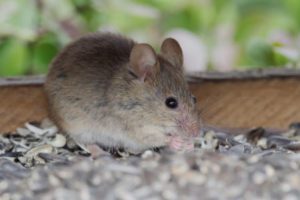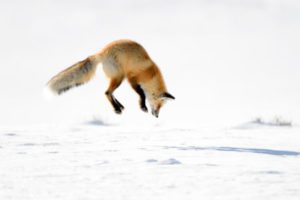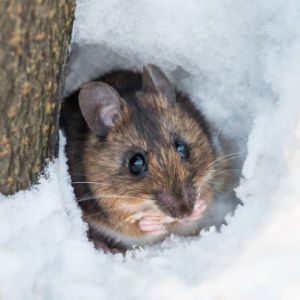What happens to mice in the snow and cold?
By Zachary Ciras on January 20, 2022.
Cold and snowy New England winters affect us all differently. We humans will often spend more time inside, cuddled up with hot cocoa streaming TV, just waiting for the days to get longer and the temperatures to get warmer.
As for mice, they do what they are so adept at doing: adapting! Mice are and have always been proficiently adaptive to any environment in which they find themselves. This has led to their distribution on every continent except for Antarctica. Mice can survive and even thrive in conditions ranging from tropical heat and humidity to the coldest of New England winters.
Ideal Conditions

House Mouse eating seeds from a bird feeder
The most desirable conditions for mice according to their biology is to be very warm. The temperature range generally accepted for keeping mice comfortable is between 86°-90°F. This is why you will commonly find mice nesting in your utility/furnace room, behind your refrigerator (that motor gets warm!), or near some hot water pipes in your home. Mice will often favor a place within a short travel to a food source, and some protection is also a key factor in determining where they will nest.
‘Snow problem!

Red Fox hunting for mice in the snow
Small rodents, including mice, voles, and shrews, can actually benefit from snowfall. Mice will burrow underneath the snow, traveling between nesting sites and food without being detected by hungry predators such as birds and foxes. Foxes can be seen intently listening for mouse sounds under the snow and then diving down to retrieve their catch, much like sea birds do when fishing. These subnivean (under the snow) tunnel systems provide a level of insulation against the sub-freezing air temperatures, maintaining temperatures closer to 32°F. These tunnels can be seen when the snow begins to melt.
We do see a decrease in mouse activity inside of homes after a heavy bed of snow has fallen and frozen, presumably making it more difficult to travel.
Do mice hibernate?
When bringing to mind animals surviving cold winters, we may consider hibernation like bears, hedgehogs, or Rip Van Winkle. There are relatively few animals considered to be true hibernators, a voluntary period of inactivity which involves sleep, lower body temperature, and slowed breathing and heart rate. Brumation is another form observed in some turtles among other animals which does not include sleep. Some animals engage in an involuntary, mild form of hibernation called Torpor. Engaging in torpor, animals can slow down their metabolic and vital systems to preserve energy when food is scarce in the winter. This leaves animals exposed to predators, so finding a safe place to check out is critical. Mice are excellent climbers and often climb trees to enter hollows and nest in relative safety. Mice create their heat as most mammals do, by using muscles to shiver and by burning oxygen and a special brown fat in their bodies. Limiting resources, mice will enter torpor. Studies have found highland Deer Mice young pups deep in torpor on mountains, where food and oxygen are both scarce.

Mice, especially the abundant Deer Mouse, will burrow and nest in the ground or use the burrows to enter structures. Burrowing near a structure such as your home is common, and when a heat source and air current are found, mice will follow the luring comfort into your home through gaps and cracks. Breeding peaks in the spring and in the fall, and it’s no surprise that’s when we see the highest levels of activity in residences.
Wintering in your home
The fall and spring tend to bring on the largest peaks of activity inside of residential structures. Having adapted well to their various environments, mice are no stranger to the cycles of seasons in New England. Come autumn, mice surge inside and prepare to nest through the winter. Finding openings possibly smaller than 1/4″, mice enter your home and claim their winter territory. Mice will often bring food inside, especially acorns, seeds, berries, and insects. If you provide them with the opportunity, mice will also eat and hoard food from your trash, pantry, cupboards, or pet food dishes and storage containers. Insects which may have entered to overwinter inside of your home’s voids are also found to be a delectable source of energy for our furry invaders.
Our homes’ numerous void cavities, insulated walls, heat pipes and heat producing electronics, and available food make it a perfect winter retreat for mice to wait out the cold months. Mice can procreate year round, especially when conditions are fitting. Providing shelter, heat, and food will invite the expansion of the rodent populations we see.
Leave them out in the cold
For most homes, exclusion of mice from entering in the first place is a reasonable goal. Some home have complications due to their construction, but we build home in part to keep the outside, well, outside. Once mice have entered the home, a rigorous control plan must be instituted to ward off the various ailments that mice can bring in. Disease, foulness, and damage can be cause by an uncontrolled mouse population. Ultimately, working with the reputable pest control service professionals at Colonial Pest Control will eliminate the existing population and work to keep them out!